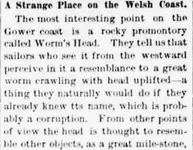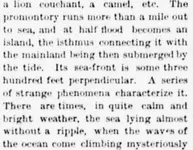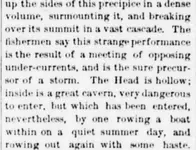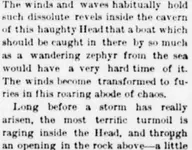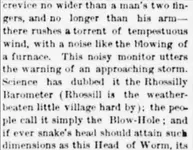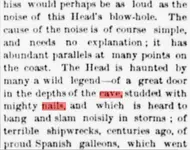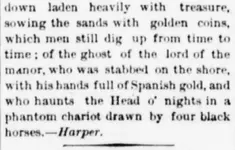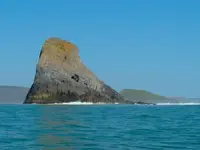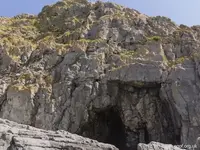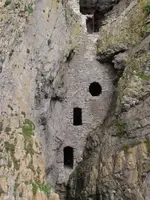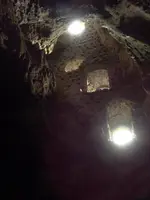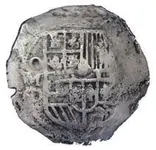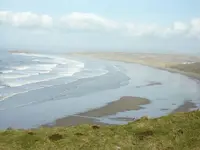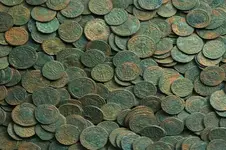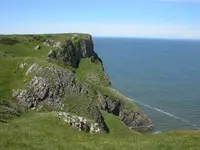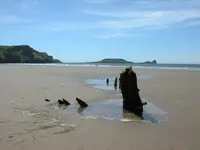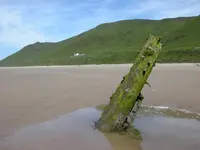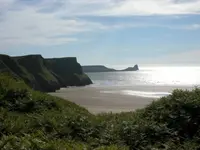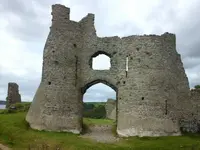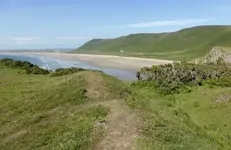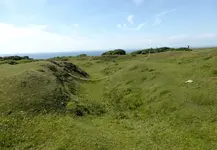Hello Jeff
Thanks for the interesting article. I always love reading these treasure yarns. Yet they can be a lesson on how the context of things are exaggerated. The Author of newspaper article has merged 3 stories into one.
Firstly the cave on Worms head is real and in fact there are several. The one they refer to with alleged door is in fact a colored rock face near the cave entrance is brownish from algae. Looking at a distance from at sea it looks like cave with a door? hence legends about a cave with a door? On northern side the outer Worms head there is blow hole. In very low tide you row a small boat into it the sea is calm. A good friend of mine when he was young feller explored over 488 caves along the welsh coast and Devon and Cornish coast. Looking for hidden smugglers loot in the late 1970's early 1980's
Secondly The story of the gold coins?
The shipwreck nicknamed the "Dollar Ship”, the precise details of which are lost in legend was shipwreck on beach further along the coast on the Gower peninsular. She may have been a Spanish vessel wrecked beyond the low tide line during the seventeenth century, possibly around the year 1660?
At one time she was believed to have been carrying a vast treasure, the dowry of Catherine of Braganza, the Portuguese princess who came to England in 1661 to marry King Charles II, and who introduced the drinking of tea to Britain?
In 1807 exceptional tides uncovered for a few hours part of a wreck beyond the low tide mark. This prompted a “gold rush” in west Gower, for Spanish coins from the early seventeenth century were uncovered. Over 12lbs in weight of Spanish dollars, half-dollars and pieces-of-eight were dug up, some coins dated 1625 and others 1639, from the time of King Philip IV of Spain - which would date that shipwreck after 1640.
As the coins were Spanish dollars, any connection with the Portuguese Catherine of Braganza can be dismissed; anyhow she had sailed to Southampton through the English Channel, not the Bristol Channel, and there was no record of any dowry being lost?
The Cambrian” newspaper of 7th March 1807 reported that the findings are conjectured to have formed part of the cargo of a rich Spanish vessel from South America, called the Scanderoon galley, which was wrecked on that part of the coast upwards of a century since.
Though the tide came in and the sands closed over the site, there was a similar “gold rush” again in 1833, when C.R.M. Talbot of Penrice waived his right as lord of the manor to the finds, so some local people had a windfall. Rev. William Griffiths, Lady Barham’s minister at Cheriton Chapel, commented on the enthusiasm with which people hastened to the beach to seek gold coins, while being unconcerned about seeking spiritual riches.
Besides coins being uncovered, there were also lead bullets, pewter, and part of an astrolabe (an old navigational instrument). According to Rev. J.D. Davies, who recounts legends as well as actual history in his “History of West Gower”, two iron cannon were also recovered, and mounted in the garden of Richard Helme at Hillend.
But the facts remains coins from the mystery shipwreck was recovered on two occasions. The identity of the shipwreck in not conclusive.
Thirdly the other story is legend of the lord of Dunraven castle even further down the coast was secretly engaging in wrecking of ships in the Bristol channel. He would with lanterns lure ships to sail onto rocks and plunder them and murder survivors. He had done this for many years and had become very rich and powerful. But he had his come comeuppance came when finally he wrecked ship carrying a ship with his only son coming back from America. And when he went plunder a bloated corpse by the shore he turned him over and discovered it was his son.
So you have 2 unrelated factual locations and stories mixed with legends presented in a way as if they part of some thing else.
Some thing to be aware of when reading into these newspaper stories.
Kanacki
